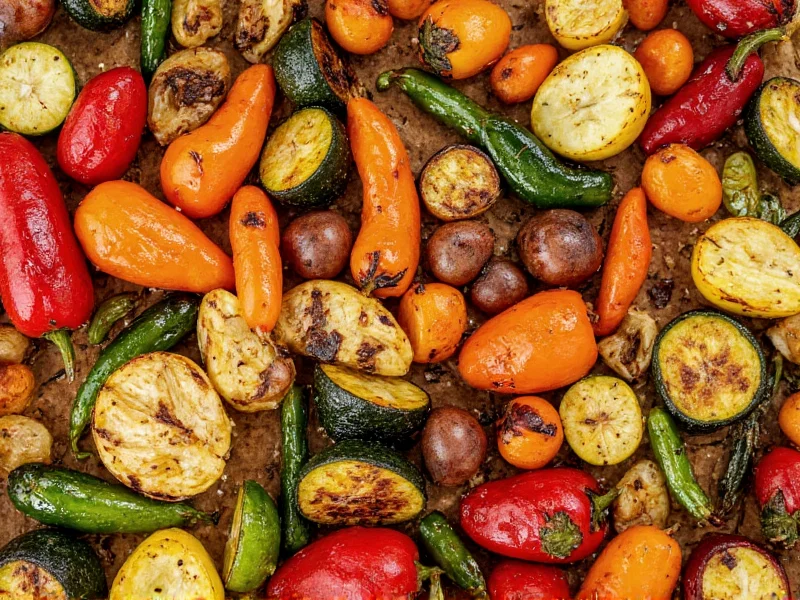Perfectly seasoned roasted vegetables transform simple produce into culinary masterpieces. Understanding which spices complement different vegetables and when to apply them makes all the difference between bland and brilliant results. This guide reveals professional techniques for maximizing flavor through strategic spice application.
The Science Behind Spice Pairing for Roasted Vegetables
When vegetables roast, their natural sugars caramelize while moisture evaporates, concentrating flavors. The Maillard reaction creates complex new compounds that interact uniquely with different spices. Robust herbs like rosemary and thyme contain volatile oils that withstand high heat, while delicate herbs like basil and cilantro are better added after roasting.
Understanding vegetable classifications helps determine ideal spice partners. Starchy vegetables (potatoes, sweet potatoes) absorb flavors well and pair beautifully with earthy spices. Cruciferous vegetables (broccoli, cauliflower) complement warm spices like cumin and coriander. Nightshades (eggplant, peppers) shine with Mediterranean herbs like oregano and marjoram.
Essential Spice Blends for Roasted Vegetables
Creating consistent, restaurant-quality results requires understanding which spice combinations work across different vegetables. These versatile blends deliver exceptional flavor with minimal effort:
| Spice Blend | Best For | Ratio |
|---|---|---|
| Mediterranean Mix | Zucchini, tomatoes, eggplant | 2 parts oregano, 1 part thyme, 1 part rosemary |
| Root Vegetable Rub | Carrots, potatoes, beets | 2 parts rosemary, 1 part garlic powder, 1 part smoked paprika |
| Middle Eastern Blend | Cauliflower, sweet potatoes | 2 parts cumin, 1 part coriander, 1/2 part cinnamon |
| Simple All-Purpose | Most vegetables | 1 part garlic powder, 1 part onion powder, 1/2 part black pepper |
Vegetable-Specific Spice Recommendations
While general blends work well, tailoring spices to specific vegetables creates extraordinary results. Consider these professional pairings when preparing your next roasted vegetable dish:
- Root vegetables (potatoes, carrots, beets): Rosemary and thyme provide earthy notes that complement natural sweetness. Add 1 teaspoon dried rosemary per pound of vegetables before roasting.
- Cruciferous vegetables (broccoli, cauliflower): Cumin and coriander create warm, complex flavors. Try our Middle Eastern blend for roasted cauliflower steaks.
- Nightshades (eggplant, zucchini, peppers): Oregano and marjoram enhance Mediterranean flavors. Add fresh basil after roasting for vibrant color and aroma.
- Alliums (onions, shallots): Thyme and a pinch of red pepper flakes balance natural sweetness with subtle heat.
- Squash (butternut, acorn): Cinnamon and nutmeg (sparingly) complement natural sweetness, especially when paired with sage.
Proper Spice Application Techniques
When and how you apply spices significantly impacts final flavor. Follow these professional techniques for optimal results:
Dry spices should be mixed with oil before coating vegetables. This emulsification helps spices adhere and prevents burning. For best results, combine spices with oil 10-15 minutes before tossing with vegetables to allow flavors to meld.
Fresh herbs generally burn at high roasting temperatures. Reserve delicate fresh herbs like basil, cilantro, and parsley for post-roasting garnish. Heartier fresh herbs like rosemary and thyme can withstand roasting when used sparingly.
Timing matters: Add robust dried spices before roasting. Incorporate delicate spices like smoked paprika during the last 10-15 minutes to preserve their nuanced flavors. Finish with fresh herbs and a squeeze of citrus after roasting.
Avoiding Common Seasoning Mistakes
Even experienced cooks make these seasoning errors when roasting vegetables:
- Overcrowding the pan: Prevents proper caramelization and causes steaming instead of roasting. Use multiple pans if necessary.
- Adding salt too early: While some salt should be included with oil, excessive salt before roasting can draw out moisture. Reserve 25% of salt for after roasting.
- Burning delicate spices: Spices like paprika and cumin burn easily. Add them during the last third of roasting time.
- Ignoring acid balance: Finish roasted vegetables with lemon juice or vinegar to brighten flavors and balance richness.
- Uniform seasoning: Different vegetables require different seasoning levels. Adjust spice quantities based on vegetable density and water content.
Creative Flavor Combinations to Try
Elevate your roasted vegetables with these unexpected but delicious pairings:
- Lemon-herb roasted potatoes: Toss baby potatoes with lemon zest, thyme, and a touch of Dijon mustard before roasting.
- Harissa-roasted carrots: Coat carrots in harissa paste mixed with olive oil for North African-inspired heat.
- Miso-glazed Brussels sprouts: Whisk white miso with rice vinegar and maple syrup for umami-rich sprouts.
- Citrus-rosemary sweet potatoes: Add orange slices to the roasting pan with sweet potatoes and fresh rosemary sprigs.
- Smoked salt cauliflower: Sprinkle smoked salt during the last 10 minutes of roasting for campfire-like depth.
Perfecting Your Roasting Technique
Temperature control significantly impacts how spices interact with vegetables. For most vegetables, 400-425°F (200-220°C) provides optimal caramelization without burning spices. Denser vegetables like potatoes benefit from starting at 425°F then reducing to 400°F after 20 minutes.
Shake the pan or stir vegetables every 15-20 minutes to ensure even browning and spice distribution. For extra crispiness, finish under the broiler for 2-3 minutes, watching carefully to prevent burning delicate spices.











 浙公网安备
33010002000092号
浙公网安备
33010002000092号 浙B2-20120091-4
浙B2-20120091-4